15 Different Parts of a staircase
The stair provides quick and easy access to one floor to another floor of the house. You must know the basic parts of a staircase before constructing it. Staircase, n the houses increase the aesthetic appearances by making it more functional.
1: Baluster:
The baluster is a vertical member of metal or wood and supporting a handrail.
- It is also called the spindle.
- It is mainly made up of plastic, steel, wood and some times with stones.
- The baluster is supporting the handrail or the caping of a parapet of the staircase.
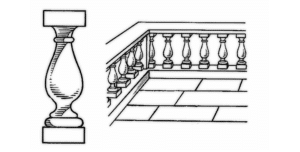
2: Handrail:
The inclined rail over the string is termed as a handrail.
- It provides stability and support.
- It is mainly used in descending and ascending staircases.
- According to the OSHA, the minimum height of handrail must be 30″(76 cm) and not more than 37″(94 cm).
- Handrails are mainly supported with the help of posts or walls.
 3: Soffit:
3: Soffit:
The soffit is the underside of the stair or bottom of the stair slab.
- Under the surface of the stair called the soffit.
- Some times it is invisible due to the under-stair construction of the store or Bath.
- It is either finished with plaster or may be covered with the ceiling.
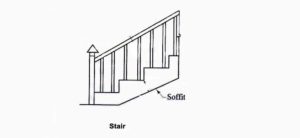
4: Waist:
The waist is the thickness of the structural slab of RCC stairs.
- In this waist the steps rest.
- It is made up of RCC or wood
- The waist is the minimum thickness perpendicular to the soffit of the staircase
- The steps on the waist area may be made up of brick, wood or concrete.
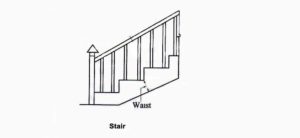
5: Nosing:
Nosing is the part of the tread beyond the face of the riser and it is usually to give good architectural shape.
- It is projected to increase trade foot space.
- It end is usually in the rounded shape.
- The nosing length is not more than 1.5″.

6: Riser:
The riser is the vertical distance between the two tread faces. According to Nptel,
- In public buildings, we mainly use the rise 150mm.
- In residential buildings, we use 190 mm mainly.

7: Tread:
Tread is the upper horizontal portion of a step in which the feet are placed. Trade is the most important part of stairs.
- The top portion of the step called tread.
- The trade length is mainly used 270 mm in residential buildings.
- 300 mm tread length is used for the public buildings.

8: Step:
The 1 trade and 1 rise make a complect 1 step and it is the important part of a staircase.
- The step area depends on the rise and tread we want to provide.
- It is maybe made up of brick, concrete or wood.
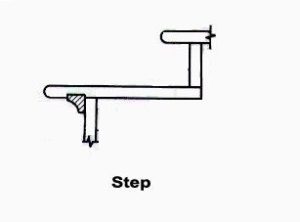
9: Flight:
The flight is a series of steps without any break or landing.
- It is made up of many steps.
- In one flight 8 to 10 or may in some places 12 to 15 steps, we constructed (According to Quora community).
- It is made up of wood or RCC.
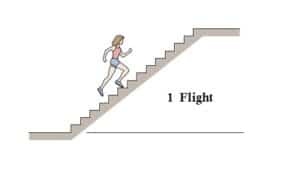 10: Landing:
10: Landing:
Landing is the platform at the top or bottom of a flight between the floors.
- Landing is present in the two excessive flights.
- It is also known as resting position in the stairs.
- We also provide to change the direction of the flights.
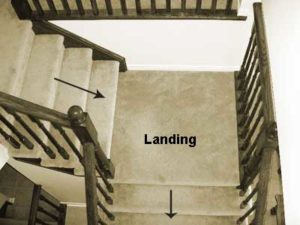
11: Run:
It is the total length of stairs in the horizontal plane.
- The length of landing length is included in the run.
- It is also calculated by adding the trade lengths and landing length (if provided).
- It is a horizontal distance of the stair.
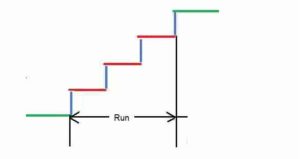
12: Going:
The horizontal distance between the first and last riser.
- It is the width of the tread between two successive risers.
- It is measured from stair nosing to nosing.

13: Pitch line:
The line connecting the nosing of all treads in a flight of stairs.
- It is an imaginary line along the nosing tip of the treads.
- The pitch slop is measured with angles (tangent)
- The horizontal line angle is measured in degrees.
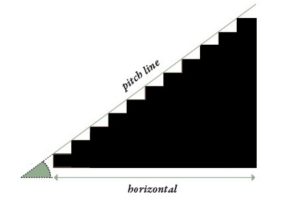
14: Pitch:
The angle between the pitch line and horizontal called pitch.
- Pitch also called a rake.
- Its angle is measured with the degree.
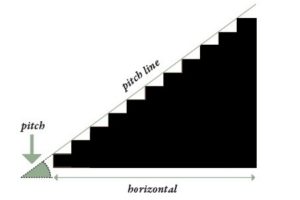
15: Blocking:
Blocking supports the underside of the steps.
- It is mainly provided in wood steps.
- It provides additional support to the step.

These parts of a staircase may pronounce differently in different languages.
IMPORTANT POINT:
The Headroom is not less than 2 meters vertically above the pitch line.
Read Also:
Shear this information with your friends…
We Love Cricket